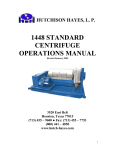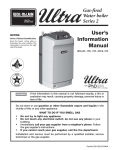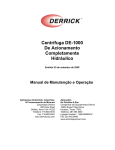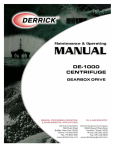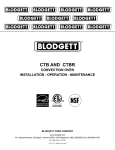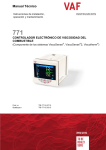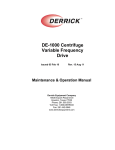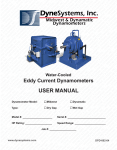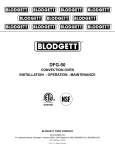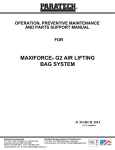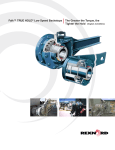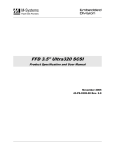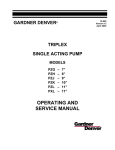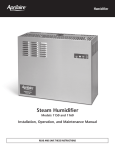Download 5500 Centrifuge with Hydraulic Backdrive Operations Manual
Transcript
5500 Centrifuge with Hydraulic Backdrive Operations Manual Revised March 2005 3520 East Belt Houston, Texas 77015 Tel: (713) 455 – 9600 ●Fax: (713) 455 – 7753 (800) 441 - 4850 www.hutch-hayes.com 1 Hutchison Hayes, L. P. NOTICE OF CONFIDENTIALITY This information is highly confidential and is solely for the benefit of Recipient 2 TABLE OF CONTENTS 5500 CENTRIFUGE WITH HYDRAULIC BACKDRIVEOPERATIONS MANUAL SECTION 1 - INTRODUCTION Overview Data Page 5 SECTION 2 -START-UP Safety Installation Pre Start – Safety Precautions Belt Tension Procedure Starting & Shutdown Procedure Hydraulic Back Drive 9 SECTION 3 - OPERATION A. Over-Torque Protection & Resetting Hydraulic Back Drive Warning B. Dam Plate Adjustment Pond Depth Chart 23 SECTION 4 - LUBRICATION A. Grease & Oil Data Lubrication Schedule 28 SECTION 5 - ASSEMBLY & DISASSEMBLY A. Rotodiff Removal B. Rotating Assembly Removal C. Conveyor Removal 1. Conveyor Disassembly D. Pillow Block Disassembly E. Front Bowl Hub F. Rear Bowl Hub G. Assembly & Disassembly Tips H. Recommended Capscrew Seating Torque I. Conveyor, Wear Protection 36 SECTION 6 - PARTS LIST Base Unit Hydraulic Back Drive Standard 61 3 Page SECTION 7 - ELECTRICAL & WIRING Hydraulic Back Drive 68 SECTION 8 - TROUBLE SHOOTING Hydraulic Back Drive Standard 72 SECTION 9 – ELEVATION, DIMENSIONS & WEIGHTS Hydraulic Back Drive 75 SECTION 10 - MISCELLANEOUS Recommended spare parts list Hydraulic Back Drive Charts Storage 80 SECTION 11 - VENDOR DATA 87 4 SECTION I INTRODUCTION 5 OVERVIEW HUTCHISON HAYES HIGH “G” CENTRIFUGE MODEL 5500 This Service Manual describes the centrifuge, and lists instructions for the installation, operation, and maintenance requirements. The basic purpose of this centrifuge is to separate the liquid and solids from the fluid feed (slurry.) A stainless steel rotating bowl, driven by a 60 H.P. electric motor is used to centrifuge the slurry; that is to sling the solids against its inside wall surface while a stainless steel screw conveyor (faced with hard tiles) gathers and conveys these solids to a central discharge area. The conveyor is driven at a slightly slower RPM through a planetary gear reducer. The liquids migrate to the front end of the machine and are dispelled through four (4) adjustable plate dam openings, to a central discharge area. For a more comprehensive description of how the centrifuge operates, see the Operation Section of this manual. 6 5500 INDUSTRIAL MODEL CENTRIFUGE DATA Normal Bowl Centrifugal Force: Normal Bowl Operating Speed: Normal Conveyor Operating Speed: 2118 G’s 3053 RPM 3022 RPM Max. Bowl Centrifugal Force: Max. Bowl Operating Speed: Max. Conveyor Operating Speed: 3110 G’s 3700 RPM 3663 RPM GB-100 Gear Unit Max. Output Shaft Torque: Max. Pinion Shaft Torque: Ratio: Differential Speed: Motor Speed: Motor Sheave: Centrifuge Sheave: 36,000 LB. IN. 363.6 LB. IN. 99.28 :1 31 RPM 1750 RPM 14” O.D. 8.025” O.D. Rated Solids Output: Bowl Inside Diameter: Bowl Length: Package Weight Empty: (Floormount Unit) 12,000 LBS./HR. 35.500 (MAX.) 16 IN. 55.56 IN. 7,365 LBS. OILFIELD MODEL (SKID MOUNTED) Normal Bowl Centrifugal Force: Normal Bowl Operating Speed: Normal Conveyor Operating Speed: Main Drive Motor BackDrive Motor Max. Bowl Centrifugal Force: Max. Bowl Operating Speed: Max. Conveyor Operating Speed: 2118 G’s 3053 RPM 2996 RPM 60 HP 60 HP 3110 G’s 3700 RPM 3630 RPM GB-53 Gear Unit Max. Output Shaft Torque: Max. Pinion Shaft Torque: Ratio: Differential Speed: Bowl Dimensions: Package Weight Empty: 54,000 LB. IN. 679 LB. IN. 53 :1 57 RPM Same as Above 8,000 LBS. (Approx.) 7 THE 5500 HIGH “G” CENTRIFUGE EQUIPPED WITH VISCOTHERM ROTODIFF HYDRAULIC CONVEYOR DRIVE The standard drive configuration for a 5500 High “G” Centrifuge uses a planetary gearbox to drive the screw conveyor. An alternative drive arrangement is available as an option. The “Viscotherm” Rotodiff Hydrostatic Slip Drive Unit may be used in place of the planetary gearbox. The unit consists of a hydraulic pump and the Rotodiff drive device. The gearbox is protected from overloading by a torque limit device which uses a preset spring loaded linkage to trip a microswitch and shut down the centrifuge and the feed pump in the event of an over-torque condition. If the Rotodiff unit is installed, then disregard any reference in this manual to the gearbox or the torque overload device. The Rotodiff and pump unit are warranted by the manufacturer, “VISCOTHERM AG and an instruction manual for each unit is included with the HH 5500 Service Manual. CAUTION It is very important that the Rotodiff Start-Up/Operation Instructions listed in the Instructions Manual be read and understood by operating personnel before any attempt to run the centrifuge is made. 8 SECTION 2 START-UP 9 SAFETY Because the 5500 High “G” Centrifuge is a high-speed, high-torque piece of rotating machinery, caution should be exercised by operating personnel. HH recommends operating personnel review the centrifuge manual before working with the equipment. Periodic safety meetings to familiarize new operating personnel with the centrifuges characteristics are also recommended. This manual is intended for use by qualified operators familiar with processing equipment and trained for this particular centrifuge. Maintenance personnel should be experienced mechanics. Electricians should be licensed, qualified personnel familiar with electrical safety procedures. CAUTION Persons without recommended experience may not understand the instructions listed in this manual A. GENERAL 1. Read all manuals and instructions before attempting to install or operate equipment, and follow all recommendations. 2. Follow all lubricating and/or greasing procedures and schedules recommended in the equipment instructions. 3. If nameplates are lost, damaged, or removed, replace them. They have been affixed to the equipment to provide warnings, instructions, etc., for the maintenance and operating personnel. 4. Do not operate belt driven or chain driven equipment without guards. If equipment was purchased without guards, user is responsible for providing proper guards that meet all applicable codes. 5. Make periodic checks for loose bolts on rotating assemblies, the supporting structure, covers, hatches, guards, and piping connections. 6. Do not operate equipment if excessive vibration or abnormal noise develops. 7. If the equipment is supplied with covers or guards, do not remove these until the equipment has come to a complete stop. 8. Never operate equipment with parts that have not been manufactured or approved by the original equipment manufacturer. B. HANDLING 1. Safe practices for lifting and handling equipment should be followed. Hoists and slings should be of adequate capacity, inspected regularly, and in good repair. 10 2. Always use extra caution when lifting, moving, or holding worn parts, since these may be sharp, slippery, or weakened. Never place hands, feet or head at possible pinch points. 3. Always provide a sufficiently large cleared area around the equipment during maintenance. C. ROTATING EQUIPMENT 1. Do not exceed the maximum speed, process material specific gravity, process pressure or temperature, or maximum design feed rate as specified on the equipment nameplate or within the operating manual. 2. Do not use a pipe wrench on any part of the rotating equipment. 3. Do not interchange parts that have been balanced as an assembly. 4. Do not attempt to utilize the rotating equipment in an application for which it was not originally selected. 5. When taking samples or removing any material from equipment like grinders, screw conveyors, open throat pumps, etc., make sure all machine components are at rest and the power is shut off with the disconnect switch locked in the off position. 6. Do not get rags, loose clothing, sticks, etc., near rotating or moving parts. 7. The equipment must coast to a complete stop. Do not brake it by hand or in any other way force it to stop, unless it is equipped with a braking mechanism supplied by the original equipment manufacturer. 8. Do not operate the rotating equipment unless the direction of the rotating part or assembly conforms to that of the Instruction and/or Operation Manual. 9. If a rotating assembly must be turned by hand, use caution: Avoid sharp edges and close areas where fingers may be cut or trapped (example: pulleys). D. PUMP 1. If positive displacement pumps are used in the process be sure the discharge line is unobstructed before starting the pump. 2. In plants using any type of grinder with the discharge directly connected to a pump, be sure that the pump is in operation before putting any product into the grinder. 3. Do not run a positive displacement pump dry. E. EXPLOSION PROOF EQUIPMENT 1. Do not operate equipment driven by an explosion-proof motor and control until all seal fittings are properly sealed with recommended fiber or compound, and tagged. 2. Never use abrasive material or a file to remove corrosion from explosionproof equipment. 3. Cover screws and bolts used to hold explosion-proof joints together must always be tight, and only of the type and material recommended by the manufacturer. 11 F. MOTOR 1. Do not neglect to check that the line voltage applied to the motor controller is the same voltage for which the motor is wired. 2. Always follow motor manufacturer’s specifications on bearing lubrication. 3. Do not attempt to operate a motor that is overheated due to frequent starts and stops. Allow the motor to cool to ambient temperature (as designated on the motor nameplate) before each restart. G. ELECTRICAL (General) 1. Install and ground all equipment (permanent and portable) in accordance with requirements of the National Electric Code and local electric codes. 2. Use circuit breakers or fused disconnects between equipment and power source. 3. Never touch electrical components with wet hands or when standing on a wet surface. Insulate yourself from ground and use insulated tools. 4. When handling electrical equipment, take care to avoid contacting live parts. Assume all circuits are live. Check with a voltmeter. 5. Label all control circuits clearly. 6. Keep electrical controls and motors clean and free of dust – dust prevents thorough air circulation, generating heat; heat in turn can ignite the dust or flammable vapors if present in the atmosphere. 7. Never wash electrical equipment unless it is constructed for that purpose. Never wash live electrical equipment. H. ELECTRICAL (Repairs) 1. Only qualified personnel, familiar with electrical safety procedures and the construction and operation of the equipment, should work on electrical equipment. 2. De-energize all power before opening any electrical enclosure, or before connecting and disconnecting test equipment and components. Provide a safety lockout at the power source. 3. Use only approved safety rubber gloves and mats, insulated tools, and eye shields when doing electrical work. 4. Periodically inspect and operate all of the automatic shut-off devices and monitoring systems provided. 5. On DC powered equipment, do not perform any inspection (mechanical or electrical) until the power has been turned off and disconnected, and all rotating assemblies have come to a complete stop. The moving motor may generate DC voltage feed back. I. CHEMICALS 1. If corrosive and/or toxic chemicals or solvents are used as part of the process or as cleaning materials: become thoroughly familiar with the properties of the products and their hazards, the precautions necessary to handle the product 12 safely, and follow all manufacturer recommendations for the type of product being handled. a. Use in well ventilated area and keep employee exposure below permissible limits. b. If flammable, take care to prevent fire or explosion. c. Avoid contact with the skin and eyes – wear goggles, gloves, shields, etc., as required by the nature of the solvent or chemical. 2. If in doubt whether a product is dangerous or not – Assume It Is. Take all necessary precautions to avoid personal injury. J. VENTILATION 1. Toxic fumes, if present in the system, must not be permitted to escape to the operating area. They should be adequately vented away form the worker in accordance with applicable environmental regulations. 2. If in doubt whether any vapor is toxic or not – Assume It Is. Take all necessary precautions to avoid personal injury or adverse health effects. Worker exposure should be maintained below the permissible limit and at the lowest feasible level. 3. If it is necessary to enter an area where toxic vapors are present, consult with responsible authorities for recommendations concerning safety. 4. Use NIOSH approved breathing apparatus when working with toxic or hazardous materials, or with materials that reduce the oxygen concentration in the air, such as carbon dioxide. K. COMBUSTIBLE PRODUCTS 1. If combustible products are used as part of the process or as cleaning products, become thoroughly familiar with the safety precautions necessary to handle the product. Follow all recommendations to avoid personal injury or property damage that could be caused by fire or explosion. L. PRESSURE VESSELS 1. Vessels operating under internal pressure should be maintained and inspected in accordance with the manufacturer instructions and/or applicable local or state codes. If corrosion or erosion is expected, frequency of inspection should be increased. Qualified personnel should make all necessary repairs. 2. Vessels operating under internal pressure should be provided with a safety device to relieve excess pressure in accordance with the Unfired Pressure Vessels Code. 3. Safety devices should be in good operating condition at all times. It is recommended that they be inspected and tested frequently and maintained in accordance with manufacturer instructions and/or applicable local and state codes. 13 4. If any repair on a safety device is necessary, return it to the manufacturer. Inexperienced personnel should never attempt repair. Any adjustment should be made according to the recommendations supplied by the manufacturer. 5. The outlet connections of all safety devices should be installed in a manner that will not cause injury to personnel should discharge or actuation occur. 6. Before attempting maintenance on pressurized equipment, reduce internal pressure to atmospheric pressure. M. HOT / COLD PRODUCTS 1. When working with very hot or very cold processes or products, extreme caution should be used to avoid personal injury. N. LEAKAGE AND SPILLAGE 1. Any leakage in the system should be quickly corrected. 2. Any type of spillage (oil, water, etc.) should be quickly cleaned off floors, walls, equipment, lines, etc., and the entire operating area kept clean. O. DANGEROUS MATERIAL APPLICATIONS HH makes both standard equipment and equipment furnished with certain explosionproof accessories (motor, controls, etc.), as specified by the purchaser. Standard equipment not furnished with explosion-proof accessories must never be used with explosive, chemically unstable, or flammable materials of any kind. Severe personal injury or property damage could result. When we supply equipment furnished with explosion-proof accessories, whether we are the manufacturer or not, we warrant that the particular accessories we describe as explosion-proof comply with accepted industry standards for that term. However, this does not mean, and we cannot and do not guarantee, that one of our machines furnished with explosion-proof accessories is safe for use with explosive, chemically unstable, or flammable materials under ALL conditions. In some instances, it may be necessary for the user to equip the machine with safety devices not ordinarily placed on equipment of this type. In other cases, the application may be so hazardous that the only prudent operating procedure is to isolate the equipment in an expendable building and operate it by remote control from a safe distance. Because HH has no control over these potential dangerous operating conditions, we do not guarantee that equipment made by us can be safely used with explosive, chemically unstable, or flammable materials, regardless of whether we installed industry accepted explosion-proof accessories. The user has the responsibility for insuring that all precautions required by his particular method of operation have been taken. P. REPAIRS 1. Do not make mechanical or electrical repairs or attempt disassembly unless the equipment has come to a complete stop, the power is shut off, and a safety lockout or other padlock is installed on the disconnected circuit. The locking device should be tagged to identify the working party. 14 2. Do not make any repairs until dangerous vapors and gases are replaced with clean air. 3. HH should be consulted before attempting to make major repairs to any of the rotating equipment we manufacture. Under no circumstances should weld repair or other alterations be made to major rotating components without the full knowledge and assistance of qualified Manufacturer personnel. Failure to obtain this assistance may result in rupture of parts involved with possible injury to personnel or damage to equipment. 4. Repairs to hard-surfaced parts must be performed with strict quality control of materials and methods. Hard-surfacing materials are brittle, and can break off if improperly applied. After startup, periodic inspection of these parts is necessary to anticipate separation of materials. 5. During repairs, when equipment may be physically or electronically unstable, post barriers or signs announcing hazardous conditions. 6. After repairs and before restarting, reinstall all guards and reconnect all mechanical and electrical safety devices. Q. CORROSION, EROSION, AND PITTING OF ROTATING EQUIPMENT 1. To insure a high factor of safety under severe operating conditions, high speed rotating equipment manufactured by HH is designed after a careful stress analysis has been made of highly stressed parts. A thorough control of metallurgical properties is maintained throughout manufacture, and all material is warranted as free of defects at time of shipment. 2. It should be noted that equipment subjected to severe erosive or corrosive environment could deteriorate over a period of time, depending on the severity of the exposure and/or possible misuse. Users of high speed rotating equipment should be aware of the fact that extremely high forces are brought into play when their equipment is in operation. Any weakening of highly stressed members by misuse, erosion, corrosion, chemical pitting, or stress cracking must be guarded against to prevent possible metal failure. 3. In the interest of longer and safer operation of the equipment, HH recommends that the equipment owner maintain a periodic (at least monthly) inspection on highly stressed rotating and/or moving parts which are subjected to erosive or corrosive wear. 4. The following points should be noted and the recommended action taken: a. Do not operate equipment when: 1. Holes are wearing through rotating and/or moving parts. 2. Grooves greater than 1/16” deep are worn in rotating and/or moving parts. 3. Evidence of cracks is present, especially in rotating and/or moving parts. 4. Chemical pitting of 1/16” depth or greater on rotating and/or moving parts. 5. Component surfaces are covered with a light corrosion or etching. b. Chemical pitting is observed: 15 All cases of chemical pitting, even less than 1/16” depth, should be watched carefully. This pitting action is almost always due to the breakdown of the passive film on stainless surfaces in the presence of chlorides. This often occurs under product cake that has not been sufficiently cleaned from the surface. High temperature, low pH, and high acidity accelerate the pitting action. 5. Contact HH regarding the repair or replacement of rotating and/or moving parts whose surface is noticeably pitted. 16 INSTALLATION Location a. b. c. d. e. f. g. Install the centrifuge unit in a location where sufficient headroom is allowed for lifting the bowl out of its’ frame enclosure. A 2-ton overhead hoist should be installed to facilitate inspection or repair work. A clear area in the vicinity of the centrifuge should be provided to set the bowl during inspection or repair. Room should be allowed at the front end of the machine for withdrawing the planetary gearbox. A zone approximately 2’0” wide x 2’ 6” long from the front end of the gearbox should be kept clear. Room should be allowed at the rear end of the machine for withdrawing the feed tube. A zone approximately 6” wide x 3’ 0” long from the end of the feed tube support clamp should be kept clear. Clear access space should be provided around the centrifuge. The centrifuge isolators should set on a smooth level surface on structural members of sufficient strength. IMPORTANT CAUTION Since this centrifuge operates at high speed and is subjected to severe wear conditions, it is important that any indications of weakening of highly stressed components be recognized before a failure can occur. To facilitate this HH recommends a monthly visual inspection on highly stressed components, such as: The bowl Shafts wear plates Wear tiles Conveyor, etc. If inspection reveals: 1. Holes worn through moving parts 2. Wear grooves greater than 1/16” thick in moving parts 3. Cracks present is moving parts 4. Chemical pitting to a depth of 1/16” or greater in moving parts DO NOT OPERATE THE EQUIPMENT UNTIL REPAIRS ARE MADE FAILURE TO FOLLOW THE ABOVE RECOMMENDATIONS MAY RESULT IN SEVERE PERSONAL INJURY OR PROPERTY DAMAGE 17 PIPING 1. Customer piping tie-ins to the centrifuge should be made with flexible connections. 2. Customer tie-in at feed tube should have a suitable pipe support so that no weight is imposed on the centrifuge feed tube. A flexible connection is required here. 3. A flush line should be provided at the feed tube tie-in. HH recommends hot water. A ball valve should be located as close as possible to the feed line to prevent plugging the flush branch with solids. 4. Use a screen at the pump suction to protect the pump and centrifuge from oversize solids. 5. Liquid discharge lines should have a minimum of ¼ " per ft. slope. 6. HH recommends installation of a pressure indicator in the feed line upstream of the customer tie-in to regulate the feed supply to the centrifuge. For HH 5500 centrifuges with Hydraulic Main Drive or Hydraulic Back Drive, the following hydraulic oil is recommended: MOBIL DTE 26. (See the Product Data Sheets on the following pages.) Caution: Other hydraulic oils should only be used with written confirmation that the oil conforms to the specifications on the MOBIL DTR 26 product. 18 PRESTART SAFETY PRECAUTIONS FAILURE TO FOLLOW THE RECOMMENDED SAFETY PRECAUTIONS LISTED BELOW MAY RESULT IN SEVERE PERSONAL INJURY OR PROPERTY DAMAGE Read through this entire list before attempting start-up Initial Installation 1. The correct bowl rotation must be verified. The bowl should rotate clockwise when viewed from the motor end (rear of centrifuge) looking inboard. The Hydraulic back drive motor should rotate clockwise looking from the top. 2. Insure that the cooling water and return line to the hydraulic back drive heat exchanger are connected, and the appropriate flow rate is set 3. The drive group enclosure guard and the gearbox shroud must be secured in place. 4. Check to see that the centrifuge unit is clear of rags, ropes, wires, or any other material which could catch or snag rotating parts. 5. All bolts and capscrews must be engaged per recommended torque requirements shown in Charts 1 and 2 at the end of this section. 6. All rings and seals should be in good condition and securely fastened. 7. The centrifuge cover should be tightly secured. 8. The frame bolts should be fully tightened. 9. Check all lubrication points. (See Lubrication Section) 10. Verify that all seal fittings at explosion-proof motor and control are sealed with CHICO X Fiber and sealing compound. 11. The drive belt should be checked for correct tension. Caution: Over tightening belts can damage the fluid coupling. (See Figure 1 at the end of this list.) 12. Electrical grounding straps must be secured in place, where required. 13. Maximum Speed, specific gravity, or pressure, indicated on the centrifuge name plate is not to be exceeded. 14. No work is to be performed on the electrical system unless the power is shut-off. 15. Check the line voltage on initial start-up to ascertain that the voltage applied to the motor controller is the same voltage that the motor is wired for. 19 16. If excessive vibration is present during start-up, shut the unit down immediately and notify HH service representative. 17. Do not replace any damaged or worn out Machine Parts with other than HH replacements. 18. The customer may replace ordinary wear parts such as oil seals, o-ring and gaskets. A replacement list is in the Parts List Section. 19. Do not open the cover or attempt removal of a shroud or belt guard until the centrifuge is motionless. 20. Use the correct tools for any assembly or disassembly work. 21. Do not supply slurry into the centrifuge until the unit is fully up to normal operating speed. 22. If more than one (1) centrifuge is in operation, never attempt to exchange any machined parts. 23. Never use a pipe wrench on any part of the centrifuge. 24. There is a slow down period as the machine decelerates towards shut-down. Leave the cover shut until the centrifuge is motionless. Do not attempt any disassembly before the machine is static. 25. Never prop the centrifuge cover partially open by using blocks of wood or any other foreign object. IMPORTANT CAUTION 26. Whenever the centrifuge cover is opened for cleaning, inspection, etc., the one (1) hinge safety pins must be engaged to prevent accidental closing of the cover, this procedure should always be followed. 27. Flexible connections should be used at all customer piping tie-ins. 28. Do not attempt any repairs to the Rotodiff at the front of the machine beyond replacement of the oil. 20 5500 HIGH “G” CENTRIFUGE BELT TENSIONING PROCEDURE FIGURE 1. 21 5500 60/60 START UP AND SHUT DOWN PROCEUDRE Start up 1. Do a visual inspection of the unit checking for any loose wire leads or electrical connections, check that all guards are in place and securely fastened. Insure the case lid is fastened securely and there are no missing or loose clamps. 2. The control panel door should be closed and secured. 3. Check for any oil leaks from the back drive unit at the pump and at the drive unit on the centrifuge. 4. Check the oil level sight glass on the back drive pump unit making sure the level is correct. 5. Check for any oil leaks at the main drive fluid coupling. 6. If any leaks are found anywhere they should be addressed and corrected immediately. 7. Insure that the feed tube and feed hose from the pump are secured. 8. Insure that any valves from the feed pump and to the feed tube are in the open position (open any valve or suction side). 9. Turn the cooling water on for the back drive pump unit. 10. Check for any leaks at the heat exchanger or the hose supplying the cooling water. Make sure there are no kinks in the cooling water supply hose. Any leaks or restrictions in the cooling water supply line could cause a shut down from over temperature of the hydraulic oil. 11. Turn main power on, the alarm lights and the horn should turn on. Push the horn silence button. Check and record any alarm lights that are not on and replace the bulb immediately. Push the reset button to reset the alarms. Any alarms that do not reset need to be addressed and corrected before going to number 12. 12. Push the start button for the back drive unit, monitor the bar pressure on the manometer. With no product the bar pressure should be less than 10 bar. 13. Check the flow for the differential speed on the flow meter sight glass. 14. Adjust the differential speed if necessary by turning the differential set point knob. 15. Push the start button for the main drive and wait until reaching full speed. 16. Check bar pressure on manometer it should be below 25 bar. 17. Be sure feed rate on the feed pump is not higher than 25gpm before starting it. 18. Start feed pump. 19. Monitor bar pressure on manometer periodically. Shut down 1. Lower feed rate on the feed pump to 25gpm. 2. Turn feed pump off. 3. Turn flush water on and let the centrifuge run for 5 minutes to clear any product still in the bowl. 4. Check bar pressure on the manometer it should be below 10 bar. 5. Push the stop button for the main drive and let it come to a complete stop before turning flush water off. 6. After main drive is at a complete stop push the stop button for the back drive. 7. Turn the cooling water off for the back drive pump. 8. Turn main power off. 22 SECTION 3 OPERATION 23 OPERATION The slurry to be separated is pumped into the feed tube, axially located at the rear of the machine. The slurry is directed into a feed chamber where it is dispersed by four (4) externally mounted feed nozzles and directed by centrifugal force along and against the inside wall of the bowl. This ring of slurry or “pond” will contain solids against the bowl wall. These solids are scrolled forward over a “beach area” by the screw conveyor and discharged through four (4) ports at the solids end of the centrifuge located in the rear. The lighter liquids migrate forward and are discharged through four (4) adjustable plate dam nozzles at the liquids discharge area located at the front end of the centrifuge; i.e. the gearbox end. 24 Over torque and resetting Hydraulic Back Drive The hydraulic back drive unit has (2) electrical safety switches, the red flag and green flag, for protecting the Rotodiff from over torque damage. Along with the electrical switches the pump unit has a mechanical bypass valve for oil flow diverting when a preset high pressure is reached. This preset pressure level cannot be altered. The pump unit also has a visual pressure manometer so that the operator can monitor pressure at all times. The green flag and red flag pressure levels can be changed to accommodate the process in which the centrifuge will be operating. The green flag is first in the pressure safety settings. It is set so that if the centrifuge begins to reach a higher than normal pressure level the green flag will turn the feed pump off, providing the installation of the feed pump has it wired into the control panel on the centrifuge. If a green flag occurs there will be an audible horn and the red light on the control panel will illuminate. 1. Once the feed pump is off the pressure should come back down to the normal operating levels. 2. The horn silence button should be pressed this will silence the horn only and not reset any lights or alarms. 3. If the pressure comes back to normal operating levels then the unit may be reset. 4. The reset button on the control panel then must be pressed. 5. The feed pump must be restarted from the control panel. The red flag is next in the pressure safety settings. It is set so that if the pressure continues to rise after the feed pump is off it will shut the centrifuge off leaving the back drive running. As the G-force goes down the back drive will continue to run to try to clear the material in the centrifuge. The centrifuge may begin to bypass through the bypass valve, if this happens the centrifuge and the hydraulic pump must be turned off. Then the hydraulic unit must be jogged on and off until the plug has cleared. Note: The hydraulic unit must not be started more than once every 30 seconds with a maximum of 5 minutes. Then the unit must set idle in the off state for 30 minutes before the cycle can start again. If this procedure does not clear a plugged centrifuge, HH must be contacted for further instruction. 25 PLATE DAMS ADJUSTMENT 1. The four (4) plate dams are used to set the “Pond” depth. 2. The plate dams are located in the front hub. Access to the plate dams is allowed by raising the centrifuge cover with the machine shut down. 3. The plate dams are adjusted by loosening three (3) capscrews and rotating the plate clockwise. 4. A Maximum Setting, (i.e., the highest number engraved on the plate aligned with the arrow mark on the front hub) will cause a maximum pond depth giving maximum clarification of the liquid. 5. A Minimum Setting (i.e., the lowest number engraved on the plate aligned with the arrow mark on the front hub) will cause a minimum pond depth and will result in the Maximum dryness of the discharged solids. IMPORTANT 6. When plate dams are indexed by rotation, all four (4) dams must be indexed to the same number. 7. After adjusting, always recheck all twelve (12) capscrews for correct tightness. 26 27 SECTION 4 LUBRICATION 28 MOBIL PRODUCT DATA SHEET MOBIL DTE® 20 Series Super-Stabilized, Antiwear Hydraulic Oils Description Mobil DTE 20 Series high-quality hydraulic oils were developed in cooperation with pump and component manufacturers specifically for severe hydraulic systems using highpressure, high-output pumps. These oils provide the superior antiwear and film strength characteristics necessary for critical systems. They are formulated from stable, highquality, high-VI base stocks and additives which provide the specific properties required in hydraulic fluids. Mobil DTE 20 Series provide outstanding performance in all standard industry tests, and are approved in the Denison HFO, Vickers V-104C and 35VQ25, and Sundstrand pump tests. Their 12 stage rating in the FZG Gear Test demonstrates a high level of protection against wear and scuffing. Mobil DTE 24, 25, and 26 are qualified against Cincinnati Milcron specifications P-68, P-70, and P-69 respectively. The super-stabilized additive system of the Mobil DTE 20 Series was selected to neutralize the formation of corrosive materials, provide excellent anti-wear properties, and multimetal compatibility. This additive system also provides better thin oil film protection against rusting, retention of superior oil cleanliness, and improved compatibility with water. Typical Characteristics Physical characteristics are listed in the table. Values not shown as maximum or minimum are typical and may vary slightly. Applications Mobil DTE 20 Series oils are Mobil’s primary recommendation for most hydraulic applications in industrial, marine and Mobil service, including high-pressure systems, with servo valves and all robotics. Advantages Mobil DTE 20 Series oils offer the following performance benefits: • Excellent keep-clean performance for systems critical to deposit buildup, such as sophisticated NC control mechanisms • Controlled demulsibility allows the oils to work well when contaminated with small amounts of water, and to separate large amounts of water readily • Multimetal compatibility under both wet and dry conditions protects pumps using steel and copper alloys • Excellent protection against rust; good thin oil film protection for surfaces intermittently wetted by oil 29 • Outstanding load-carrying and antiwear properties provide superior protection against wear Health & Safety Based on available toxicological information, these products produce no adverse effects on health when properly handled and used. No special precautions are suggested and beyond attention to good personal hygiene, including laundering oil-soaked clothing and washing skin-contact areas with soap and water. To obtain Material Safety Data Bulletins, to request additional technical information, or to identify the nearest U.S. Mobil supply source, call 1-800-662-4525. Mobil DTE 22 Product Number 60260-7 Gravity API 32.6 Specific Gravity 0.862 Pour Point °C -23 (-10) (°F), max. Flash Point °C 202 (395) (°F), min. Viscosity, 22 eSt at 40° C 4.5 eSt at 100° C 11.5 SUS at 100° F 41 SUS at 210° F ISO Viscosity 22 Grade Viscosity Index 95 Rust Protection ASTM 665 Color, ASTMD 2 1500, max. Mobil DTE 24 60262-3 30.4 Mobil DTE 25 60263-1 28.4 -23 (-10) -23 (-10) Mobil DTE 26 60264-9 27.5 0.89 -23 (-10) 202 (395) 202 (395) 204 (400) 32 5.3 165 44 32 46 6.7 238 49 46 68 8.5 3.35 55 68 95 ..…Pass.…. 95 95 3.5 4 4 Mobil Oil Corporation TECHNICAL PUBLICATIONS 3225 Gallows Road, Fairfax, Virginia 22037-0001 Due to continual product research and development, the information contained herein is subject to changes without notification © Copyright 1983, 1984, 1985, 1987, 1989, 1990, 1991, 1992, 1995. All rights reserved Mobil DTE 20 Series PDS I-04 6095001 (01-09-95) 30 RECOMMENDED LUBRICATING GREASE FOR THE 5500 CENTRIFUGE CHEVRON SRI-2 or MOBIL SHC 220 Lubrication fittings are located at the pillow block housing (front and rear) and on the front and rear hub shafts for conveyor bearing lubrication. NOTE: The conveyor bearing grease fittings are located inside the machine frame, and the cover must be opened to gain access to the grease fittings. NOTE: Pillow block and conveyor bearings are shipped from our manufacturing plant with the proper amount of grease. 31 Royal Purple NEW IMPROVED SYNERGY ™ HIGH PERFORMANCE GEAR OIL SYNERGY is an ultra-tough, multi-service gear oil designed to smoothly lubricate all types of gears under all conditions. Synergy outperforms other E.P gear oils because it contains Synslide ™, our proprietary synthetic oil film so tough and tenacious it is not squeezed out of the pressure area. It virtually eliminates both gear and bearing wear – even under severe “squeeze film” conditions caused by extremely high loads, sudden shock loads, or low Rpm’s. Slippery synthetic molecules increase the lubricity and oiliness of SYNERGY. Gears run smoother, quieter, cooler and longer without overhauls. SYNERGY is non-corrosive to both ferrous and non-ferrous metals. Its ability to separate rapidly and completely from water prevents sludge and wear found in wet gear boxes (such as cooling tower gear boxes). SYNERGY employs a unique, dense, high molecular weight synthetic cushioning additive to prevent fatigue failure in gears subjected to sudden loads. SYNERGY’S exclusive performance advantages: Severe Service – performs under loads where other E.P. gear oils fail Lower Coefficient of Friction – saves energy and reduces temperatures High Temperature Performance – eliminates harmful deposits – extends oil drains Cushioning Molecules – reduces fatigue failures in bearings and gears Environmentally Safe – non-toxic as all components are on TSCA’s approved list and fully comply with all OSHA and EPA guidelines Synslide ™ - proprietary, slippery, tenacious, ultra-tough synthetic film Prevents Corrosion – protects both ferrous and non-ferrous metals during operation and shut-down Water Separation – complete separation of oil and water to prevent emulsion Compatibility – 100% compatible with both mineral and synthetic gear oils Customer Benefits: Saves Money – Saves energy, extends gear box life and reduces down-time Multi-Applications – one oil for all gears – spur, helial, herringbone, worm, etc. Multi-Conditions – for all speeds, all horsepower, all loads and all temperatures Superior Lubrication – smoother, quieter, cooler, more efficient gear boxes Recommended For: All Gear Boxes – regardless of type, horsepower, speed, load or temperature All Metals – non-corrosive to both ferrous and non-ferrous metals All Service – shock load, high pressure, high and low temperature All Users – ready for a quantum leap in gear box performance 32 33 34 Hutchison Hayes 5500 Centrifuge Lubrication Schedule Frequency Lubricant Pillow Block Bearings: 24 Hrs Run Time 2 Shots per fitting Chevron SRI-2 Mobil SHC-220 **Conveyor Bearings: 15 Days Purge till relief Chevron SRI-2 Mobil SHC-220 Gearbox: First Oil Change after 500 hrs. of operation, then every 6 months. Royal Purple Synergy Gear Oil ISO Grade 150 SAE 90 AGMA Grade 4EP Torque Control Linkage: 6 months NEVER-SEEZ Compound Fluid Coupling: “FORMSPRAG” Model 12.4 HSD ABOVE 130 DEG. F. SAE 10W Fyrquel 550 Houghto Safe 1010 BELOW 130 DEG. F. SAE 5W Fyrquel 90 Houghto safe 1010 Pydraul 29E LT 138 Fl. Oz. Cap. (fill#11) Change oil every 4000 hrs. For fire resistant fluid, every 10,000 hrs. or every two years. (See Vendor Section of this manual for complete filling instructions) ** After every washing or steam-cleaning of the conveyor, check the conveyor bearing lubrication. 35 SECTION 5 ASSEMBLY AND DISASSEMBLY 36 HYDRAULIC BACK DRIVE ROTODIFF REMOVAL STEPS: 1. Follow all lock out and tag out safety procedures. Insure power is off. 2. Remove guard over Rotodiff. 3. Remove low-pressure hose from port block on the rear of Rotodiff. A “T” on the block marks the low-pressure hose. Keep hose elevated to prevent oil from leaking. Cover hose end to prevent foreign debris from entering. 4. Remove the high-pressure hose and follow same procedure as in #3. A “P” on the block marks high-pressure hose. 5. Place a sling (held by the overhead hoist) under the Rotodiff. 6. Remove the six (6) metric adaptor hub screws. 7. Using two (2) of the cap screws just removed, jack the gearbox out of the adaptor hub. 8. With the sling carrying the Rotodiff weight, carefully withdraw the Rotodiff and set it on its side in a clean, clear area. 9. Remove the spline shaft by pulling it straight out of the centrifuge. 10. To reinstall the Rotodiff the spline shaft must be removed from the centrifuge and installed into the Rotodiff first then inserted back into the centrifuge for installation. Do not attempt to dismantle the Rotodiff. A damaged Rotodiff must be returned to HH for repairs. 37 ROTATING ASSEMBLY REMOVAL STEPS: 1. Remove gearbox shroud by removing six (6) capscrews and slowly lifting vertically. 2. Carefully remove the drive group enclosure. 3. Remove drive belt by moving the motor toward towards the centrifuge using the Nema adjust motor base to slacken the belt. (The adjusting bolt is 3/ 4”, 1-1/ 8” across the hex flats.) 4. Disconnect the feed-line to centrifuge. 5. Untighten feed tube clamp by loosening four (4) bolts. Do not remove feed tube clamp cover. 6. Remove feed tube. It pulls straight out. 7. Remove the front and rear pillow block dowel pins by jacking them out using the threaded connection at the top of the pins to withdraw them. 8. Remove pillow block bolts. 9. Fully open centrifuge cover and secure one (1) safety latch pins. 10. Using hardened capscrews, attach bowl lift lugs at front and rear of bowl. 11. Using the bowl spreader-bar, attach shackles to lifting lugs and slowly lift the bowl and rotodiff assembly as a unit, if rotodiff has not been removed prior to this step, using the 2-ton overhead hoist. 12. Set the assembly down horizontally in a clean clear area. 38 CONVEYOR REMOVAL Positioning bowl for conveyor removal (After the gearbox has been removed) 1. With bowl assembly now sitting horizontally in a clear, clean work area, remove the bowl spreader bar. 2. Attach the conveyor lifter to the adaptor hub (at gearbox end of centrifuge) using four (4) 7/16 – 14 UNC X 2 3/ 4” long bolt with heavy hex head nuts. The rotodiff should have been removed prior to this procedure. 3. Place the bowl assembly on a support stand as shown in Figure 1. 4. Height “H” in diagram must be tall enough so the drive sheave (pulley) clears the floor by at least two (2) inches. CAUTION: Never allow the drive shaft to contact any surface during this lifting procedure. It is not designed to carry any load and can easily be damaged. 5. The weight must be carried through the rear hub resting on the stand. With the bowl assembly now resting securely in an upright position: 6. Remove the twelve (12) 3/8” / capscrews from the front hub at top end of the bowl assembly. 7. Using four (4) bolts just removed, screw them into the four (4) jackscrew holes and remove the hub. 8. Once the front hub is jacked free, it can be lifted out with the overhead hoist. 39 9. Set this front hub, pillow block, and gearbox adaptor hub assembly in a clean, clear space. 10. Unbolt the Conveyor Lifter Plate from the gearbox adaptor hub just removed. 11. Remove four (4) capscrews from the seal housing at the end of the conveyor and attach the Conveyor Lifter Plate. 12. Slowly hoist out the conveyor. 13. Set the conveyor upright on a smooth, clean and clear work area. 14. With the hoist still attached to the conveyor, secure the conveyor assembly with ropes so it cannot topple over. 15. Once secured, disconnect the hoist connection and remove the Conveyor Lifter Plate. CONVEYOR DISASSEMBLY FRONT CONVEYOR BEARING REMOVAL 1. If the front conveyor bearings are in good condition, they do not need to be pulled. Disregard Steps 2, 3 and 4 and go to Step 5. 2. If the Front Conveyor Bearings are worn out or damaged, remove the six (6) capscrews from the liquids and seal housing. 3. Jack out the liquids end seal housing using two (2) capscrews just removed. 4. Using a slide hammer type bearing puller, remove the two (2) bearings. 5. Remove the Conveyor Bearing Housing by removing the eight (8) capscrews and jacking it out using two (2) of the removed capscrews. This opens the end of the Conveyor Tube and allows access to the Accelerator Plate and Feed Chamber Liner. ACCELERATOR PLATE AND FEED NOZZLES 1. The accelerator plate is removed by inserting the long T-handle wrench into the conveyor tube and screwing it tightly into the threaded hub on the centerline of the accelerator plate. 2. With the T-handle wrench * attached firmly, loosen the two (2) 3/8’setscrews and the two (2) 3/8’ lockscrews from the conveyor tube. They are located just forward from the feed nozzle located on the outside of the conveyor tube. 3. With the setscrews and lockscrews backed-off enough to allow the plate to be pulled out, slowly withdraw the accelerator plate. 40 4. Remove the four (4) externally mounted feed nozzles by unscrewing two (2) capscrews at each nozzle and withdrawing each nozzle by gripping its’ flange and pulling it out. 5. Note the condition of the O-Ring on each feed nozzle. * T-handle wrench (available from HH) CONVEYOR REAR BEARING HOUSING REMOVAL 1. Remove the conveyor as per the previous Conveyor Removal Section, but set the conveyor in a horizontal position on a clean, clear work surface. 2. Remove the conveyor lifter plate from the front of the conveyor. 3. Carefully raise the conveyor to a vertical position with the front end (gearbox end) resting on a very clean surface. 4. Remove the rear bearing housing by unscrewing the six (6) 1/ 4” capscrews. 5. Using two (2) of the screws just removed, place them in the two (2) jackscrew locations and evenly jack the solids-end bearing seal housing (Item 11) out. 6. Inspect the two (2) oil seals, and the O-Ring for any damage. If damaged or worn, remove them. 7. Inspect the ball bearing. If it is in good condition, go to Step 10. 8. If the bearing must be replaced due to wear or damage, reinsert the six (6) capscrews in the rear bearing housing to stabilize it for pulling the ball bearing. 9. Use a slide hammer type bearing puller to extract the bearing. 10. Remove the six (6) capscrews from the rear bearing housing and using two (2) of them, jack-out the bearing housing, the retainer tube assembly will come out with the rear bearing housing. 11. Remove the six (6) capscrews from the retainer tube flange. 12. Pull the retainer tube assembly out. 13. Inspect the front oil seals for wear or damage. If the front oil seals are worn or damaged, they will have to be replaced. 14. To replace the two (2) front oil seals, the bearing must be pulled. Replace the rear bearing housing into the conveyor and replace the six (6) capscrews. 41 15. Remove the ball bearing using a slide hammer type bearing puller. 16. Remove the oil seal retaining ring. 17. Pull the two (2) oil seals and replace them. 18. Remove the rear bearing housing. Now access is clear for removal and inspection of the retainer tube seal. RETAINER TUBE SEAL REMOVAL 1. Reach into the conveyor and remove the four (4) 1/ 4” capscrews on the seal retainer plate. 2. Pull the seal retainer plate out. 3. Inspect the oil seal and replace if worn or damaged. 42 Item No. 1 1A 2 3 6 9 10 11 Part Numbers Hutchison Hayes 5500 High ‘G’ Centrifuge HH Machined Components Description HH Part 12 13 15 16 17 18 19 19A 20 21 22 Bowl Bowl Liner Bowl Extension Conveyor Flinger Rear Hub Conveyor Bearing Housing (Solids End) Conveyor Bearing Seal Housing (Solids End) Retainer Ring Retainer Tube Pillow Block Housing Pillow Block Housing Bearing End Plate Spacer Ring Flinger Cover Flinger Cover (nearest gearbox) Flinger Case Flinger Feed Tube Assembly 24 27 28 29 35 Accelerator Plate Assembly Feed Nozzle Wear Liner @ Feed Nozzle Solids Discharge Wear Insert Drive Sheave 36 37 38 39 40 41 42 Drive Sheave Seal Housing Conveyor Bearing Housing (Liquids End) Splined Adapter Front Hub Seal Housing (Liquids End) Plate Dam Gearbox Adaptor Hub 04065 04052 04053 04073 04050 04054 04083 04071 04010 04058 04058 04059 04081 04060 04072 04073 04084 04009/ 13994 04056 04057 04046 04062 04061/ 04001 04087 04055 04078 04051 04063 04067 03062 * S.T.C. (Sintered Tungsten Carbide 43 Item No. 12 43 Item No. 100 101 102 103 Item No. 200 201 202 203 204 Item No. 205 207 Item No. 24d 300 304 302 305 306 Item No. 400 401 Seal Retaining Rings Customer Replaceable Items Description Snap Ring Solids Bearing Housing Snap Ring Liquid Seal Housing Bearings Customer Replaceable Items Description Rear Pillow Blow Bearing Front Pillow Blow Bearing Conveyor Bearings, Rear (Solids End) Conveyor Thrust Bearings, Front (2-Req’d) Oil Seals Customer Replaceable Items Description Seal for the Rear Seal Housing Seal for the Rear Bearing Housing Sheave Seal Retainer Tube Seal Front Seal Housing Seal All seals good for 300F Gaskets Customer Replaceable Items Description Drive Sheave Gasket Dam Plate Gasket O-Rings Customer Replaceable Items Description O-ring accelerator plate O-ring solid end seal housing O-ring Liquid hub & conical section O-ring feed nozzle O-ring liquid end Seal Housing Inner O-ring liquid end seal Housing Inner Grease Fittings Customer Replaceable Items Description Grease Fitting, Non-Corroding 1/8” PTF Straight Type Grease Pressure Relief Fitting HH Part 04036 04037 HH Part 04042 04043 04040 04041 HH Part 04032 04031 04033 04030 04032 HH Part 04069 04068 HH Part 04022 04023 04025 04020 04024 04021 HH No. 03089 03088 44 5500 CONVEYOR ASSEMBLY 45 5500 CONVEYOR ASSEMBLY (CONTINUED) 46 PILLOW BLOCK DISASSEMBLY 1. Stamp the top of the pillow block assemblies with an “S” for solid and an “L” for liquid, also stamp the top with a “V” with the point directed toward the bowl assembly. Be sure to stamp the horseshoe covers and pillow block covers on both sides of the pillow also. 2. Remove the six (6) bolts that retain the two (2) horseshoe covers and remove the horseshoe covers. 3. Remove eight (8) bolts from the sheave and using jack bolts remove the sheave from the bowl hub. 4. For liquid hub, remove the gear flange. 5. Using a two (2) or three (3) jaw puller, remove the pillow block as an assembly. Put a plate across the top of the hub for the stud to push on. 6. Remove the two pillow block covers and remove the bearing from the housing. 7. Loosen the two (2) setscrews in the pillow block flingers and the case flingers and remove both from the hub. 8. Clean all parts thoroughly and assembly in reverse order. 47 REAR PILLOW BLOCK ASSEMBLY (SOLIDS AND LIQUIDS END) 48 BOWL FRONT HUB ASSEMBLY FRONT HUB AND BOWL SHELL ARE BALANCING AND STAMPED WITH BOWL ASSEMBLY: THEREFORE, THEY MUST BE REASSEMBLED WITH “V” MARKS IN LINE AS SHOWN 49 BOWL REAR HUB ASSEMBLY REAR HUB AND BOWL SHELL EXTENSION ARE BALANCED AND STAMPED WITH BOWL ASSEMBLY: THEREFORE, THEY MUST BE REASSEMBLED WITH “V” MARKS IN LINE AS SHOWN 50 PLATE DAM ASSEMBLY 51 ASSEMBLY TIPS MAINTENANCE CAUTIONS FOR THE 5500 HIGH ‘G’ CENTRIFUGE Bearings: The inner and outer race must be replaced as a set. Opened bearing, or cleaned parts should be kept covered until assembly. Always use a thermometer to check the temperature of oil used to heat the bearings. If no heat is used to install bearings, use only an arbor press to insert bearings in place. Correctly lubricate all bearings before operating the centrifuge. Do not wash new bearings with solvent before installing. Keep new bearing wrapped and boxed until ready for use. Seals: Avoid touching the sealing surface. Keep seals wrapped in soft tissue until ready for installation. Threaded Connections: All threaded connections and pilot diameters should be wiped clean and lubricated with an anti-galling compound such as NEVER-SEEZ. Torque all screws on the rotating assembly per the “Recommended Capscrew Seating Torque” charts shown in the Start-Up Section of this Manual. To help prevent capscrew failure – if excessive torque is required to seat mating parts during assembly, the over torqued screws should be removed, discarded and replaced with new screws installed at the correct torque. O-Rings: Inspect for nicks and cuts before installing, if damaged, do not install. Lubricate O-Rings for easier installation. 52 Machined Parts: Clean with degreasing solvent before reassembly. Set parts on clean work area and protect finished surfaces and openings on the part. Be sure to align any balanced parts on the rotating assembly by matching the VMarks stamped on the parts. If more than one (1) centrifuge is owned, do not interchange any parts which comprise a balanced rotating assembly. 53 Some Assembly and Disassembly Tips 1. Read the Service Manual 2. Keep all mating surfaces free from dirt and handle carefully to avoid nicks and burrs to the mating surfaces. 3. Check the inside of the conveyor for solids build-up Not cleaning solids build-up can be the cause of vibration problems. 4. Lubricate O-Rings and fasteners when reassembling centrifuge components. Anti-seize compound should be used on stainless steel fasteners because of their tendency to gall when used with mating stainless steel parts. 5. Follow the recommended torque values shown in the torque chart in the Service Manual. 6. Conveyors equipped with carbide tiles should never be set down directly on a concrete floor. The carbide is very brittle and tile damage could result. 7. Monitor items such as drive belts, O-Rings, seals, and vibration isolators. These items will become brittle with age and deterioration will adversely affect centrifuge performance. Replace these items when indicated by inspection. 54 5500 HARDWARE INVENTORY ITEM # POSITION QTY ALLOY TYPE STYLE SIZE LOCK TIGHT OR NEVER SEIZE CONVEYOR 1 ACCELERATOR PLATE 2 SS 2 FEED NOZZLES 8 SS 3 SPLINE ADAPTER TO BRG. HSG. 8 BLACK SET/CUP SOCKET HEAD 3/8" X 1" SOCKET HEAD 1/2" X 3/4" SOCKET HEAD 3/8" X 1" DOWEL PIN 4 SPLINE ADAPTER 4 5 LIQ BRG HOUSING 12 BLACK SOCKET HEAD 3/8" X 1 3/4" 6 LIQ BRG HSG SEAL COVER 6 SS SOCKET HEAD 3/8" X 1 1/4" 7 8 SOLID END BRG HSG SOLID END BRG HSG SEAL COVER 6 SS (HELD BY ABOVE) SOCKET HEAD 5/16" X 3 3/4" 242 LOCTITE 242 LOCTITE NEVER SEIZE 3/8" X 1" NEVER SEIZE NEVER SEISE NEVER SEIZE BOWL 1 BOWL EXTENTION 12 SS SOCKET HEAD 3/8" X 1 1/4" 2 SOLID END HEAD 8 SS 3/8"X 1 1/4" 3 SOLID END HEAD WEAR PLATE 8 SS SOCKET HEAD SOC.FLAT HEAD 3/8" X 3/4 4 LIQ END HEAD 12 SS SOCKET HEAD 3/8" X 2" 5 DAM PLATES 12 SS SOCKET HEAD 5/16" X 7/8" 6 DISCHARGE PLOWS 28 SS SOCKET HEAD 3/8" X 3/4" NEVER SEIZE NEVER SEIZE 242 LOCTITE NEVER SEIZE NEVER SEIZE 242 LOCTITE 55 PILLOW BLOCK BEARINGS (BOTH LIQ AND SOLIDS END ARE TYPICAL) 1 PILLOW BLOCKS TO BASE 8 BLACK BLACK HEX HEAD SOC. FLAT HEAD 2 END COVER 4 3 HORSE SHOE COVER 4 5 6 7 3/4 X 3" 3/8" X 1" 12 SS SOCKET HEAD 3/8" X 1 1/4 CASE FLINGER 2 SS SET/CUP 5/16 X 1/2" GREASE FLINGER GREASE ZERT GREASE RELIEF 6 6 1 SS PLATED PLATED SET/CUP HEX HEX 3/8" X 5/8" 1/8" NPT 1/8" NPT NEVER SEIZE NEVER SEIZE NEVER SEIZE NEVER SEIZE NEVER SEIZE N/A N/A GEAR END 1 GEAR FLANGE 8 BLACK 2 GEAR BOX 12 BLACK GEAR FLANGE TO HEAD 4 4 GEAR FLANGE FOR HYD BD (ROTODIFF) 8 BLACK 5 ROTODIFF 12 BLACK GEAR FLANGE FOR HYD BD (ROTODIFF) 4 3/8" X 1 1/4" SOCKET HEAD 7/16" X 1 3/4" DOWEL PIN 3 6 SOCKET HEAD BLACK NEVER SEIZE NEVER SEIZE 1" SOCKET HEAD 1/2 X 1 1/4 SOCKET HEAD 16MM X 60 DOWEL PIN NEVER SEIZE NEVER SEIZE 1/2 X 1 1/4 SHEAVE 1 SHEAVE 8 2 SHEAVE TO HEAD 4 BLACK SOCKET HEAD DOWEL PIN 3/8" X 1 3/4 NEVER SEIZE 1" 56 SUB BASE TO SKID SHOCK MOUNTS 1 SHOCK MOUNT TO SKID (LONG SKID) 16 SS HEX HEAD 2 SHOCK MOUNT TO SKID (STD. SKID) 12 SS HEX HEAD 1/2" X 1 1/4" FLAT AND LOCK WSHR. 1/2" X 1 1/4" FLAT AND LOCK WSHR. NEVER SEIZE NEVER SEIZE 5/8" X 3 1/2" FLAT AND LOCK WSHR 5/8" NEVER SEIZE NEVER SEIZE NEVER SEIZE NEVER SEIZE NEVER SEIZE SUB BASE TO SHOCK MOUNT 1 2 BOLT THROUGH SUB BASE NUTS UNDER SHOCK MOUNT 8 8 SS SS HEX HEAD EXTRA HEAVY BASE TO SUB BASE 1 BOLTS THROUGH BASE 4 SS HEX HEAD 5/8" X 4 1/2" FLAT AND LOCK WSHR 2 FEED TUBE ARM TO BASE 4 SS HEX HEAD 5/8" X 2" LOCK WSHR 3 FEED TUBE ARM CAP 6 SS SOCKET HEAD 4 EYE BOLT HOLES 4 SS HEX HEAD 3/8" X 1 3/4" 3/4" X 1 1/2" FLAT AND LOCK WSHR CASE TO BASE 1 BOLTS THROUGH CASE TO BASE 8 SS HEX HEAD 5/8" X 1 1/2" FLAT AND LOCK WSHR 2 3 TEFLON IN CASE COVER SAFETY PIN 6 1 SS PLATED HEX HEAD HITCH PIN 5/16 X 1" FLAT AND LOCK WSHR 5/8" X 2 NEVER SEIZE NEVER SEIZE GEAR GUARD 1 BOLTS THROUGH GUARD 6 SS HEX HEAD 3/8" X 1" FLAT AND LOCK WSHR 2 BACK DRIVE LOCK OUT PLATE 4 SS HEX HEAD 3/8" X 1" FLAT AND LOCK WSHR 3 BACK DRIVE LOCK OUT PLATE 4 SS NUT 3/8" NUT NEVER SEIZE NEVER SEIZE NEVER SEIZE 57 BELT GUARD 1 BOLTS THROUGH GAURD TO SUB BASE 6 SS HEX HEAD 3/8" X 1" FLAT AND LOCK WSHR 2 TORQUE BLOCK 4 BLACK SOCKET HEAD 3/8" X 2" NEVER SEIZE NEVER SEIZE 1 MAIN DRIVE MOTOR MOUNT TO SUB BASE 5/8" X 2" FLAT AND LOCK WSHR NEVER SEIZE MD MOTOR TO SUB BASE 4 SS HEX HEAD ELECTRIC BACK DRIVE BACK DRIVE 1 FLANGE BRGS. FOR AUTOGARD 4 SS HEX HEAD 2 BRG. MOUNT TO BACK DRIVE ARM 4 SS HEX HEAD 3 BACK DRIVE ARM TO BASE 4 SS HEX HEAD 4 GEAR GUARD 7 SS HEX HEAD 5 LOCK OUT PLATE 4 SS HEX HEAD 6 BD MOTOR MOUNT TO SUB BASE 4 SS HEX HEAD 3/8" X 1" FLAT AND LOCK WSHR 3/8" X 1 1/4" FLAT AND LOCK WSHR 1/2" X 1 3/4" FLAT AND LOCK WSHR 7 AUTOGARD ON SHAFT 1 BLACK SOCKET HEAD 3/8 SET SCREW NEVER SEIZE NEVER SEIZE NEVER SEIZE NEVER SEIZE NEVER SEIZE NEVER SEIZE 242 LOCTITE 3/8" X 1" FLAT AND LOCK WSHR NEVER SEIZE SET/CUP 1/2" X 3" LOCK WSHR 1/2" X 1 3/4" FLAT AND LOCK WSHR 1/2" X 1 3/4" FLAT AND LOCK WSHR MAIN DRIVE 1 BELT GUARD 5 SS HEX HEAD 58 RECOMMENDED CAPSCREW SEATING TORQUE Follow recommended seating torques when assembling all socket head cap screws. Nominal Size 1 /4 5/16 3/ 8 1/ 2 Recommended Seating Torque Coarse Thread (Lubricated)* 75 in lbs 6.25 ft. lbs. 135 lbs. 11.25 ft. lbs 240 in lbs 20 ft. lbs. 600 in lbs 50 ft. lbs CHART I (STAINLESS STEEL) Nominal Size 1/ 4 5/16 3/ 8 1/ 2 3/ 4 Recommended Seating Torque Coarse Thread Dry Plain Plated 150/13 112/9 305/25 230/19 545/45 410/34 1300/108 970/81 3300/275 Coarse Thread Lubricated* Plain Plated 120/10 90/7.5 245/20.4 185/15.4 435/36 330/27.5 1040/87 775/65 3520/293 2640/220 CHART 2 (ALLOY STEEL) IN. LBS./FT. LBS * Lubricate with “Never-Seez” or equivalent. 59 Flighting Tile Caution Caution The Flighting Tiles used on the 5500 conveyor may be the spray-on hard face type or the sintered tungsten carbide backing tile type. The backing tile type is comprised of stainless steel backing plate, a sintered tungsten carbide tile and a copper/silver solder “sandwich” between the two. Even though the rotating assembly is comprised of 316 S.S., the copper will not withstand attack by highly corrosive chemicals such as sulfuric and nitric acids. If the copper/silver solder tile bond is attacked by corrosive chemicals, the result will be tiles coming loose during centrifuge operation. To avoid this potentially costly problem, always check any chemicals for compatibility with copper/silver solder before attempting to introduce them into the centrifuge. 60 SECTION 7 PARTS LIST 61 PARTS LIST To order parts contact: Hutchison Hayes, L. P. P. O. Box 2965 Houston, Texas 77252 3520 East Belt Houston, Texas 77015 Tel: (713) 455-9600 Fax: (713) 455 7753 (800) 441 4850 Web site: www.hutch-hayes.com Email: [email protected] The parts listed in this section are customer replaceable components, except for the machined items, which should be ordered from HH. 62 5500 CENTRIFUGE BASE UNIT PARTS LIST Qty. Part # Description 2 2879 5500 Flange gasket 3 2926 Case hinge washer 1 2989 Solid head wear plate (2 per set) 16 3044 Hinge pin for lid clamp 19 3044P 16 3047 Clamping shoe for case 16 3048 Eyebolt for clamping shoe 17 3049 Nut for clamping shoe 1 3056 Solid end discharge transition 1 3057 Liquid end discharge transition 1 3088 Relief grease fitting 7 3089 Grease fitting 4 3123 Expanding dowel pins for PB 4 3441 Dam plates 2 3710 Warning stickers 1 3994 Feed tube (Heavy Duty) 4 4020 O-ring, feed nozzle 1 4021 O-ring, liquid end seal housing - Inner 2 4022 O-ring, accelerator plate 1 4023 O-ring, solid end seal housing 1 4024 O-ring, liquid end seal housing - Outer 2 4025 O-ring, bowl ext. and liquid head 2 4031 Seal, solid end conv. Bearing Housing 4 4032 Seal, sol. And Liquid Seal Housing. 1 4034 Case cover assy. 1 4036 Rtn. Ring 1 4037 Rtn. Ring 1 4040 Bearing, solid end conv. Cotter pin 63 5500 CENTRIFUGE BASE UNIT PARTS LIST (CONTINUED) Qty. Part # Description 2 4041 Bearing, liquid end conv. 1 4042 Bearing, solid end PB 1 4043 Bearing, liquid end PB 1 4050 Solid end bowl hub 1 4051 Liquid end bowl hub 1 4052 Bowl extension 1 4053 Axial flow conveyor 1 4054 Solid end conv. Bearing Housing 1 4055 Liquid end conv. Bearing Housing 1 4056 Accelerator plate 4 4057 Feed nozzle with carbide insert 2 4058 Pillow block 4 4059 Pillow block cover 3 4060 Horse shoe cover 1 4061 Sheave for bowl 4 4062 Wear inserts plows 1 4063 Liquid end conv. seal housing 1 4064 Gear flange 1 4065 Bowl assembly with liner 4 4068 Dam plate gasket 1 4072 Horse shoe cover gear end 3 4073 Pillow block flinger 1 4078 Spline adapter 1 4080 Rtn. Ring for sol. End seal housing 2 4081 Pillow block spacer 1 4083 Solid end conv. Seal housing 2 4084 Case flinger 1 4091 Base assy. 1 4098 Nameplate 64 5500 CENTRIFUGE BASE UNIT PARTS LIST (CONTINUED) Qty. Part # Description 1 4100 GB-53 gearbox 1 4779 Teflon wear liner for case 5500 HYDRAULIC BACKDRIVE PARTS LIST Qty. Part # Description 1 2927 1 2941 1 3061 1 3062 1 3071 1 3072 MOTOR, 60 HP, EXP. PROOF, C-FACE CONTROL PANEL, 5500 W/ HYD. BACK DRIVE SPLINE SHAFT 5500 TO 1071D-GV-L ROTODIFF GEAR FLANGE 5500 FOR 1071D/GV-L ROTODIFF HYDR SLIP DRIVE ROTODIFF 1071 DGV/L HYDR PUMP UNIT TYPE C 45-100K W/O MOTOR 6 3164 4 3178 ISOLATOR 1448 (STARTOR RACK) ISOLATOR, 1448 (BASE OR SUB BASE) 65 5500 HYDRAULIC OIL FIELD SKID PARTS LIST Qty. Part # Description 12 2654 Main drive Motor wire 1 2918 Gear guard 1 3083 Slide base 60 hp 1 3086 Main drive motor 60 hp 1 3121 Main drive v-belt 6 3164 Control panel isolators 1 3997 Main drive belt guard 1 3998 Oil fiel skid 1 3999 Sub base 6 4013 Skid isolators 1 4019 Dual drive motor sheave 1 4044 Centrifuge step sheave 1 3094 Vibration switch 66 5500 HYDRAULIC BACKDRIVE CONTOL PARTS LIST Qty PART# Mfr PN Description 1 4721 CA7-85-10-120 MAIN DRIVE CONTACTOR - CA7 85 10 120 1 4722 MAIN DRIVE OVER LOAD - CEP7 A85 8510 1 4723 1 4724 1 4725 CEP7-A-858510 CEP7-A32-3210 HMCP 100 R3C CO 250 E2AFB 1 4728 CA 7-12-120 2 4729 1 4730 GO2-GR12DN34 KTA 7-25S16A 1 4654 1 4837 BACK DRIVE OVER LOAD - CEP7 A32 32 10 MAIN BREAKER - HMCP 100R3C TRANSFORMER - CO250 E2AFB FEED PUMP CONTACTOR 10 HP 120V COIL PUSH BUTTON STOP/START FEED PUMP BREAKER - KTA7-25S-16A ISB BARRIER EXH1A8 HANDLE 67 SECTION 7 ELECTRICAL & WIRING 68 WIRING SPECS Cable size and length for 5500 Hydraulic Backdrive Unit Main drive motor 60 HP Back drive Hyd motor 60 HP Vibration switch High temp low oil switch Red flag and Green flag switches J box to panel 8' 8' 6' 8" 6" 9" 6/4 gexol armored and sheathed 6/4 gexol armored and sheathed 18/2 gexol armored and sheathed 1 Pair shielded 1 Pair shielded 4 Pair shielded 753-C 1 1/4" 753-C 1 1/4" 753-O-1/2" CGB 192 CGB 192 CGB 194 753-C 1 1/4" 753-C 1 1/4" 753-O-1/2" CGB 192 CGB 192 CGB 194 69 70 71 SECTION 8 TROUBLE SHOOTING 72 Centrifuge Trouble Shooting (* Hydraulic Unit Only) BEFORE PERFORMING ANY REMEDIES FOLLOW THE PROPER LOCK-OUT, TAG-OUT PROCEDURES Problem Unit will not start Centrifuge shuts down Possible Cause Vibration switch tripped Remedy Reset switch No power Check source Blown fuses Replace & trace cause Drive starter Repair or replace Drive failure Repair or replace Overheated Drive Cool, restart, trace problem Torque control switch tripped *Low Oil Level *High Oil Temperature *Pump Unit in Red Flag Condition Blown fuse Reset, trace problem Fill to Correct Level Wait till Oil Cools Correct Possible Pack-Off in Centrifuge Replace, trace cause Overload relays tripped Reset Overheated drive motor Cool, trace cause Vibration switch tripped Reset, trace cause Torque control switch tripped Reset, trace cause Excessive Vibration *Red Flag over-Torque condition Correct Pack-Off in Centrifuge *High Oil Temperature Wait till Oil cools *Low Oil Level Isolators improperly secured Fill to appropriate level Tighten Flexible piping not used at machine connections Repipe Conveyor flights plugged with solids Flush or clean as required 73 Concentrate not clear Solids not dry Conveyor dead chamber filled with product Remove feed tube & flush conveyor with high pressure Loose fasteners or components Tighten Gearbox or Rotodiff misaligned Shim, recheck runout Pillow block or conveyor bearings damaged Install new bearings. Bowl parts worn Repair, replace, rebalance Conveyor flights worn Incorrect Pond Depth Repair, replace, rebalance Change setting Conveyor flights worn Repair or replace *Wrong differential Speed Change differential speed on pump unit Feed temperature too low Readjust temperature Feed rate too high Readjust Emulsification of liquids or degradation of solids (* Hydraulic Unit Only) Pump speed is too high 74 SECTION 9 ELEVATIONS, DIMENSIONS & WEIGHTS 75 76 77 78 COMPONENT WEIGHTS AND DIMENSIONS Description Weight lbs. 5500 components 5500 Variable Speed Skid Unit 5500 Brake Smart Skid Unit 5500 Oil Field Skid Unit 5500 Hyd. Back Drive Unit 5500 Full Hyd. Unit 5500 Base Unit 5500 Case and Cover 5500 Rotating Assembly (no g.b.) 5500 Bowl Assembly Complete (no conv.) 5500 Conveyor Assembly Complete GB 53 Gearbox 5500 Brake Panel VFD Control Panel 8200 8300 8200 10400 12,800 5,100 1,000 2,000 1250 750 250 1100 1,400 79 SECTION 10 MISCELLANEOUS 80 Recommended Spare Parts List for Two (2) Years Service For the 5500 Centrifuge HH Part Quantity 04043 04042 04041 04040 04032 04030 04032 04068 04025 04031 04024 04025 04022 04023 1 1 2 1 2 1 2 4 1 2 1 1 2 1 04020 *04057 *04062 04045 04013 02852 03121 4 4 4 1 6 2 1 Description Pillow Blk. Bearing, Front Pillow Blk. Bearing, Rear Conveyor Bearing, Front Conveyor Bearing, Rear Oil Seal, Solids End Oil Seal, Drivesheave Oil Seal, Liquids End Gasket, Plate Dam O-Ring, Bowl Extension Oil Seal, Retainer Tube O-Ring, Conveyor Liquid End O-Ring, Bowl Liquid End O-Ring, Accelerator Plate O-Ring, Solids End Seal Housing O-Ring, Feed Nozzle Feed Nozzle Wear Insert/Scraper Assembly Drivebelt (3053 Bowl RPM) Vibration Isolators 240 L. Filter V-Belt 3V-5GR1120 for 5500 Step Sheave Item (101) (100) (103) (102) (200) (203) (204) (207) (301) (201) (305) (304) (24D) (300) (303) (27) (29) (804) Op Spares 2 Years 4 4 8 4 8 4 4 16 6 6 6 6 6 4 8 8 8 2 12 2 1 *Indicates Custom Part Available from HH Only 81 82 83 Storage of HH Centrifuge Recommended indoor storage and rust prevention procedures for new horizontal decanting centrifuges (long-term storage implies periods in excess of three (3) months idle time.) Note: It is the responsibility of the owner to protect and maintain the equipment after shipment from HH. If the centrifuge is not to be installed immediately after shipment, the unit should be left in the original factory packaging. Centrifuge Assembly: 1. All accessible openings are closed with tape, overwrap, plugs, etc., for protection. 2. Nameplates are covered with tape. 3. Electrical devices such as the junction box, vibration shutdown switch, microswitches, conduit boxes, etc., are wrapped with overwrap* and protective tape. *Overwrap refers to any self-adherent, grease, oil and waterproof material which can be molded around component parts. 4. The grease lubricated pillow block bearings are filled with the specified grease at the factory prior to shipment. 5. The planetary gearbox is filled with the specified lube oil at the factory prior to shipment. 6. The fluid coupling (located at the main drive motor output shaft) is filled with the specified oil at the factory. Guidelines for Long Term Storage 1. The centrifuge should be stored in a building with a minimum temperature of 50 Deg. F. (10 Deg. C.). The storage area should be a clean, dry place free from excessive vibration, high humidity, dust, or corrosive fumes. 2. The unit should be tagged with instructions for startup after an extended period of storage. 3. Any loose parts should be boxed with rust inhibitor paper. No paper should be placed on the base of the box and machined unpainted surfaces should be coated with a rust preventive product. 4. The centrifuge assembly should be placed on a sturdy wooden platform. The platform boards should be spaced with 1/ 4” gap between the boards. 84 5. A protective waterproof shroud should cover the entire centrifuge assembly, top and four (4) sides. Storage Maintenance 1. The centrifuge rotating assembly should be rotated by hand at least six (6) times every three (3) months. 2. Leave the sealed openings on the equipment closed. 3. Touch-up any damaged paint surfaces. 4. Do not paint rotating parts or threaded surfaces. 5. Motors should have their shafts rotated every three (3) months in order to keep the bearings lubricated and prevent rusting. Coatings & Oils At regular intervals during equipment storage, all exposed-machined surfaces unpainted steel parts, shafts, pipe fittings, etc., should be examined for signs of rust, pitting, and moisture. These parts should be thoroughly cleaned and coated with the appropriate medium listed below: 1. Molykote Metal Protector (Dow Corning) A wax type rust preventative, which may be sprayed, brushed, or dipped onto bare steel parts. This product dries to a hard, dry film, which is almost invisible. For long storage periods, or shipment overseas, an overwrap must be used. 2. Rust Veto 342 (Houghton Co.) A soft amber colored material leaving a transparent, dry plastic film on the coated part. Applied by brushing, dipping or spraying, it is used for maximum heavy-duty protection on interior or exterior surfaces with or without a covering. Before using the treated part, remove rust veto with solvent. 85 3. Rust Veto 377 (Houghton Co.) A light, polar type water-displacing oil. It is used on metal parts stored indoors. It can be sprayed on intricate parts and bearings. Long-term storage requires an overwrap. Removal from the treated part is not required before use. An equivalent is “Antirust #77” WD Oil by International Chemical. 4. Rust Veto Concentrate (Houghton Co.) A rust preventive that is mixed in one (1) part with nine (9) parts lubricating oil, or hydraulic oil, etc. It is circulated through gearboxes and hydraulic systems and then drained before shipment. It is compatible with most hydraulic oils and removal is not required before use. 5. Ferrocote 346 (Quaker Chemical Co.) A heavy oil which leaves a soft, paste like film on the part surface. Used for outdoor storage, it must be used with overwrap. The treated part must have this coating removed with solvent before use. Contact each Manufacturer as required to determine if the rust preventives are compatible with the type of oil you are using. 86 SECTION 11 VENDOR DATA 87 88 89 90 91 92 93 94 95 96 97 98 99 100 101 102 103 104 105 106 107 108 109 110 111 112 113 114 115 116 117 118 119 120 121 122 123 124 125 126 127 128 129 130 131 132 133 134 135 136 137 138










































































































































